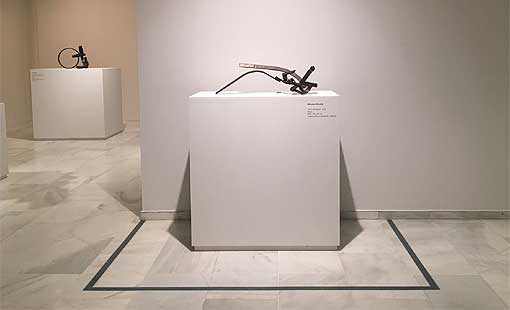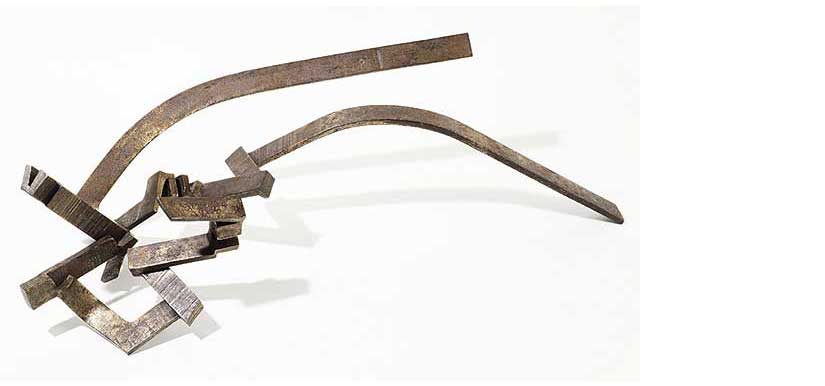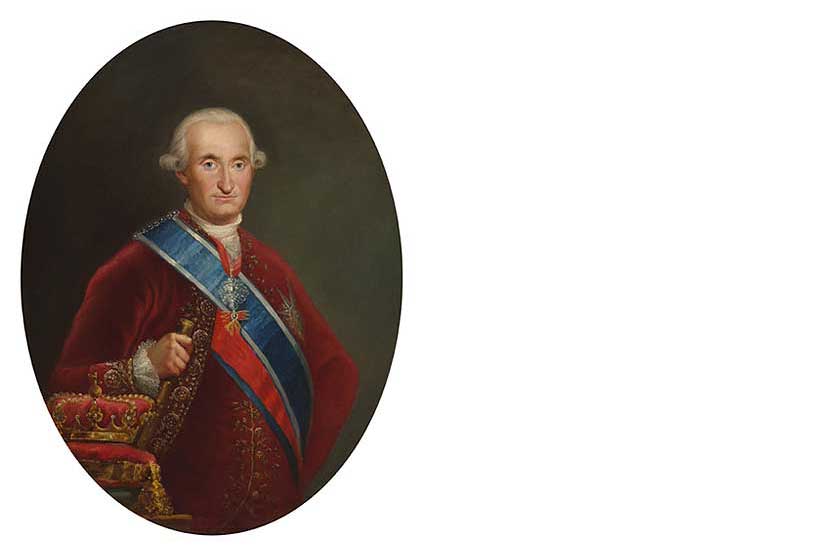
Works from our Collection feature in several exhibitions now on in Cordoba, Valencia and Madrid
The Andalusian Centre for Contemporary Creation (C3A![]() ) in Cordoba, the Bancaja Foundation
) in Cordoba, the Bancaja Foundation![]() in Valencia and the La Villa Cultural Centre
in Valencia and the La Villa Cultural Centre![]() in Madrid are currently staging exhibitions that include works from the Banco de España Collection. In the same way as the loans in the first half of 2021 to the Museum of Fine Arts of Valencia
in Madrid are currently staging exhibitions that include works from the Banco de España Collection. In the same way as the loans in the first half of 2021 to the Museum of Fine Arts of Valencia![]() , Tenerife Art Space (TEA)
, Tenerife Art Space (TEA)![]() , Bombas Gens Art Centre
, Bombas Gens Art Centre![]() and the Patio Herreriano Museum
and the Patio Herreriano Museum![]() in Valladolid, they highlight the Banco de España's firm commitment to bringing its art collection to the attention of the public. That commitment has also led to the arranging of a number of temporary exhibitions, the first of which has just opened under the title 2328 reales de vellón, and to the publication in 2020 of a Catalogue Raisonné of the Collection.
in Valladolid, they highlight the Banco de España's firm commitment to bringing its art collection to the attention of the public. That commitment has also led to the arranging of a number of temporary exhibitions, the first of which has just opened under the title 2328 reales de vellón, and to the publication in 2020 of a Catalogue Raisonné of the Collection.
The bank has worked with the C3A, founded in 2016, on an exhibition entitled Behind the Horizon Line![]() [Tras la Línea del Horizonte] featuring Etel Adnan (b. Beirut, 1925 - d. París, 2021), a Lebanese painter, academic, poet and writer who passed away on Sunday 14 November, just three days after the exhibition opened. In this case the piece on loan is Untitled #232 (2014), a fine example of her characteristic, small-format painting style in which she returns again and again to the same landscapes. Carlos Martín writes that she uses them to condense her vision of the world and foster encounters with the intangible. Swiss critic Hans Ulrich Obrist has described Adnan as one of the most influential artists of the 21st century. In this oil painting, she uses static segments of flat colours to reduce a mountainous landscape to a bare minimum structure, not in an attempt to turn it into a geometrical object but rather, in her own words, to express the overwhelming energy that nature always shows when it is observed carefully.
[Tras la Línea del Horizonte] featuring Etel Adnan (b. Beirut, 1925 - d. París, 2021), a Lebanese painter, academic, poet and writer who passed away on Sunday 14 November, just three days after the exhibition opened. In this case the piece on loan is Untitled #232 (2014), a fine example of her characteristic, small-format painting style in which she returns again and again to the same landscapes. Carlos Martín writes that she uses them to condense her vision of the world and foster encounters with the intangible. Swiss critic Hans Ulrich Obrist has described Adnan as one of the most influential artists of the 21st century. In this oil painting, she uses static segments of flat colours to reduce a mountainous landscape to a bare minimum structure, not in an attempt to turn it into a geometrical object but rather, in her own words, to express the overwhelming energy that nature always shows when it is observed carefully.
 Etel Adnan: Untitled #232 (2014)
Etel Adnan: Untitled #232 (2014)
The Bancaja Foundation Gallery on Plaza de Tetuán in Valencia city centre is the venue for the exhibition Jorge Oteiza & Eduardo Chillida Dialogue in the 1950s & 60s![]() , which opened on 5 November. This is the first time that works by these two Basque sculptors have been shown together. The focus is on a period in their careers in which they were very close in terms of both friendship and their art. Around 100 works are on show, including Rumour of Limits I (1958), a sculpture by Eduardo Chillida that belongs to the Banco de España Collection. Guipúzcoa-born Chillida sculpted mainly in iron. Here, he creates a sketch in space that is clearly influenced by Julio González but also evokes Basque craftsmanship in that it calls to mind hand-forged farm implements. Isabel Tejeda writes that Chillida takes his material to its limits, getting iron to vibrate as it meets the air so that the whole work gives off a paradoxical sense of weightlessness. Our collection also includes a work by Jorge Oteiza, the other sculptor featured in the exhibition: In Praise of Discontent) (1991) is sculpted in Corten steel. It stands three metres high, and dominates the hall of the Banco de España's secondary headquarters in Madrid.
, which opened on 5 November. This is the first time that works by these two Basque sculptors have been shown together. The focus is on a period in their careers in which they were very close in terms of both friendship and their art. Around 100 works are on show, including Rumour of Limits I (1958), a sculpture by Eduardo Chillida that belongs to the Banco de España Collection. Guipúzcoa-born Chillida sculpted mainly in iron. Here, he creates a sketch in space that is clearly influenced by Julio González but also evokes Basque craftsmanship in that it calls to mind hand-forged farm implements. Isabel Tejeda writes that Chillida takes his material to its limits, getting iron to vibrate as it meets the air so that the whole work gives off a paradoxical sense of weightlessness. Our collection also includes a work by Jorge Oteiza, the other sculptor featured in the exhibition: In Praise of Discontent) (1991) is sculpted in Corten steel. It stands three metres high, and dominates the hall of the Banco de España's secondary headquarters in Madrid.
 Eduardo Chillida: Rumour of Limits 1 (1958)
Eduardo Chillida: Rumour of Limits 1 (1958)
For the exhibition Sabatini’s Madrid. Construction of a European Capital City (1760-1797)![]() [El Madrid de Sabatini. La construcción de una capital europea] on at the Sala Fernán Gómez at the Centro Cultural de la Villa until 30 January 2022, the bank has loaned out a portrait of King Charles IV of Spain painted by Mariano Salvador Maella in 1789. In this oval-shaped picture, Maella shows Charles IV dressed in purple velvet, wearing the insignia of the Order of the Toisón de Oro and carrying his military staff of command. Both these elements highlight his status as royalty. It was painted to mark his coronation, perhaps to decorate one of the temporary monuments erected on the streets of Madrid to celebrate his coming to the throne. The influence of Francisco de Goya can be seen to a certain extent.
[El Madrid de Sabatini. La construcción de una capital europea] on at the Sala Fernán Gómez at the Centro Cultural de la Villa until 30 January 2022, the bank has loaned out a portrait of King Charles IV of Spain painted by Mariano Salvador Maella in 1789. In this oval-shaped picture, Maella shows Charles IV dressed in purple velvet, wearing the insignia of the Order of the Toisón de Oro and carrying his military staff of command. Both these elements highlight his status as royalty. It was painted to mark his coronation, perhaps to decorate one of the temporary monuments erected on the streets of Madrid to celebrate his coming to the throne. The influence of Francisco de Goya can be seen to a certain extent.
 Mariano Salvador Maella: Charles IV of Spain (1789)
Mariano Salvador Maella: Charles IV of Spain (1789)
Several works painted directly by Mariano Salvador Maella or produced at his studio are on show at the exhibition 2328 reales de vellón, which looks at the origins of the Banco de España Collection. They include a portrait of the future Charles IV (1783) when he was Prince of Asturias. This work was intended to be paired with a portrait of Princess María Luisa of Parma. Alfonso Pérez Sánchez writes that these two works were probably painted by Andrés Ginés de Aguirre, one of Maella's top pupils. Two more works by Maella or from his studio feature in 2328 reales de vellón, along with documents from the Historical Archive and the Library of the Banco de España including drawings by Francesco Sabatini for public works funded by the Banco de San Carlos. The first is King Charles III in Armour (1783) and the second is St Charles Borromeo Administering the Viaticum to the Dying during the Plague in Milan (1786).
